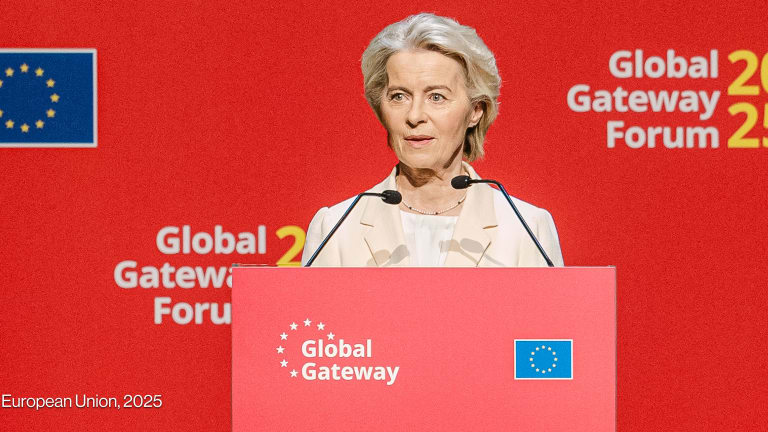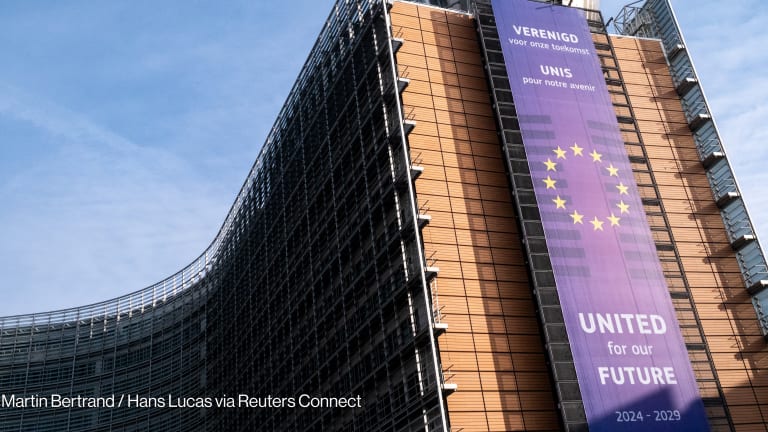EU aid to least developed countries is trending way down
Between 1990 and 2022, the share of European Commission aid going to LDCs dropped from 52% to 19%.
The European Commission’s new unapologetic focus on global partnerships designed to serve its own interests has dismayed foreign aid advocates over what they say is a shift away from poverty eradication in the least developed countries, or LDCs. When it comes to LDCs, data from the Organisation for Economic Co-operation and Development requested by Devex indicates they are right to be concerned. Between 1990 and 2022, the share of the commission’s official development assistance, or ODA, going to LDCs dropped from 52% to 19%, bucking the trend among major donors. Counting all major Western donors measured by the OECD Development Assistance Committee (including the commission), the proportion of aid going to LDCs fluctuated but measured a slight increase from 36% in 1990 to 37% in 2022. The commission did better when taking into account donors’ average yearly contribution over the period, giving an average of 37% per year to LDCs, compared to 34% for France, 33% for Germany, 38% for Japan, 46% for the U.K. and 40% for the U.S. However, of those donors, the commission stands out regarding its steady decline in the share of ODA going to LDCs. France and Germany’s share of ODA going to LDCs also fell, from 40% to 29% and from 35% to 28%, respectively. However, the pair also notched high points over the 32-year period, with France peaking at 51% and Germany 46%, both in 2003. U.K. aid to LDCs was 46.5% of its ODA in 2022, more or less the same proportion as in 1990, which was 47%. While the share of ODA going to LDCs rose in Japan (23% to 41%), and the U.S. (25% to 42%). Finalized OECD figures for 2023 are not yet available, though a commission spokesperson told Devex by email that the share of its ODA going to LDCs rose slightly last year compared to 2022. The spokesperson wrote that when taken together, the collective ODA of the commission and EU national governments — what the commission calls “Team Europe” — represents the largest contribution to LDCs. “The EU’s collective ODA to LDCs has been increasing since 2015 to 2022,” the spokesperson wrote, adding that in June 2024, EU states had “reiterated their commitment” to meet the United Nations’ target of providing 0.15%-0.20% of GNI to LDCs in the short term and 0.20% of GNI to LDCs by 2030. In that June 2024 document, however, EU states also expressed concern that EU collective ODA (meaning the commission and member states) to LDCs as a share of GNI was falling — down from 0.12% in 2017-2020 to 0.11% in 2021 and then 0.10% in 2022. Mr. November The OECD figures are likely to give fresh ammunition to members of the European Parliament, as they prepare to grill the incoming EU commissioner responsible for development policy, Jozef Síkela, on Nov. 6. European Commission President Ursula von der Leyen asked Sikéla in her public mission letter to support “a differentiated approach” to LDCs, “focusing more effectively on their specific vulnerabilities and to conflict areas, fragile countries, and other complex settings.” However, if confirmed by the European Parliament, the former Czech minister for trade and industry’s main mission over the next five years will likely be scaling up the commission’s Global Gateway initiative. Billed as Europe’s answer to China’s Belt and Road initiative, the Gateway is supposed to prioritize transformational green and digital infrastructure investments, ideally with the involvement of European companies. The commission, the EU’s executive arm, said spending (and lending) abroad in areas like critical raw materials and green energy (where it has a strategic interest of its own) is perfectly consistent with helping those countries reach the United Nations Sustainable Development Goals. But, the chair of the parliament’s Development Committee, Barry Andrews, told Devex recently that the commission could open itself to litigation at the European Court of Justice if it strays too far from its treaty obligation to make tackling poverty the primary objective of its development assistance. Leave no one behind The concept of LDCs was coined at the United Nations in the early 1970s to refer to the low-income countries on earth facing the steepest obstacles to economic development. An initial list of around two dozen countries has grown to 45 members, with seven countries — Botswana, Cape Verde, the Maldives, Samoa, Equatorial Guinea, Vanuatu, and Bhutan — graduating out of the category. According to the U.N., LDCs host about 40% of the world's poor. They make up 13% of the world’s population, but only about 1.3% of global GDP and less than 1% of global trade and foreign direct investment. That makes them difficult places to deploy budget guarantees and blended finance that combines grants and loans — however, those are the modalities the commission is increasingly favoring in its development cooperation as it tries to incentivize private sector investment. Jutta Urpilainen, the outgoing EU commissioner responsible for development, told Devex in Washington, D.C., recently that she saw the commission now in a “post-ODA era.” “We use ODA funding, but we use that in a new way, in a more efficient way,” she said. “We try to use public resources in order to leverage private investment.” That followed the top civil servant in Urpilainen’s development department, Koen Doens, telling the European Parliament’s development committee last month that “simply spending ODA grant money as a charity gift in partner countries has hardly lifted any of them out of poverty.” A key test of the bloc’s new approach was this year’s midterm review of the commission’s 2021-2027 foreign aid instrument, 93% of which must be eligible to be counted as ODA. The review also coincided with orders from EU national leaders to cut €2 billion from development spending. In response, the commission — the world’s third-largest provider of ODA — chose to significantly reduce individual country allocations in favor of creating regional “investment envelopes” designed to enhance its flexibility to support the private sector. A document shared with EU states shows an average annual reduction across LDCs of 35% for 2025-2027 when compared to the amounts allocated for 2021-2024, according to Devex’s calculations. Funding for the Central African Republic is set to drop 72% for 2025-2027 compared to 2021-2024, Togo and Guinea-Bissau by 48%, and Madagascar, Malawi and Mozambique by 45%. “I’m forced to implement the decisions taken,” Urpilainen told Devex, referring to EU national leaders’ February decision to cut the commission’s foreign aid. However, Urpilainen insisted that “when we look at our spending and what is the priority for us in terms of funding, least developed countries are our priority.” And she cited the €29.2 billion allocation for sub-Saharan Africa within the commission’s roughly €79.5 billion foreign aid instrument for 2021-2027. Around two-thirds of countries in sub-Saharan Africa are LDCs. Though many of those that aren’t, such as Ghana, Côte d’Ivoire, Nigeria, South Africa, Kenya, and Namibia, are key targets for recent European investments. ‘Disappointing’ Niels Keijzer, a senior researcher at the German Institute of Development and Sustainability, told Devex by email that the EU’s progress toward its goal to spend 0.2% of GNI as ODA to LDCs was “disappointing.” And he added that the bloc may find itself in the spotlight at the U.N. Financing for Development conference in Spain next year. Keijzer noted that Bangladesh — by far the largest LDC in terms of population size — is among the countries expected to graduate from LDC status in 2026, which would further complicate efforts to hit the 0.2% target. Overall, Keijzer wrote, “many LDCs are fragile and conflict-affected states where it is hard to manage development cooperation programmes (i.e. spend ODA) and to do so effectively.” <div class='tableauPlaceholder' id='viz1730705221718' style='position: relative'><noscript><a href='#'><img alt='Final ' src='https://public.tableau.com/static/images/OD/ODAbyincomegroup1990-2022/Final/1_rss.png' style='border: none' /></a></noscript><object class='tableauViz' style='display:none;'><param name='host_url' value='https%3A%2F%2Fpublic.tableau.com%2F' /> <param name='embed_code_version' value='3' /> <param name='site_root' value='' /><param name='name' value='ODAbyincomegroup1990-2022/Final' /><param name='tabs' value='no' /><param name='toolbar' value='yes' /><param name='static_image' value='https://public.tableau.com/static/images/OD/ODAbyincomegroup1990-2022/Final/1.png' /> <param name='animate_transition' value='yes' /><param name='display_static_image' value='yes' /><param name='display_spinner' value='yes' /><param name='display_overlay' value='yes' /><param name='display_count' value='yes' /><param name='language' value='en-US' /><param name='filter' value='publish=yes' /><param name='showShareOptions' value='false' /></object></div> <script type='text/javascript'> var divElement = document.getElementById('viz1730705221718'); var vizElement = divElement.getElementsByTagName('object')[0]; if ( divElement.offsetWidth > 800 ) { vizElement.style.width='580px';vizElement.style.height='677px';} else if ( divElement.offsetWidth > 500 ) { vizElement.style.width='580px';vizElement.style.height='677px';} else { vizElement.style.width='100%';vizElement.style.height='727px';} var scriptElement = document.createElement('script'); scriptElement.src = 'https://public.tableau.com/javascripts/api/viz_v1.js'; vizElement.parentNode.insertBefore(scriptElement, vizElement); </script>
The European Commission’s new unapologetic focus on global partnerships designed to serve its own interests has dismayed foreign aid advocates over what they say is a shift away from poverty eradication in the least developed countries, or LDCs.
When it comes to LDCs, data from the Organisation for Economic Co-operation and Development requested by Devex indicates they are right to be concerned.
Between 1990 and 2022, the share of the commission’s official development assistance, or ODA, going to LDCs dropped from 52% to 19%, bucking the trend among major donors.
This story is forDevex Promembers
Unlock this story now with a 15-day free trial of Devex Pro.
With a Devex Pro subscription you'll get access to deeper analysis and exclusive insights from our reporters and analysts.
Start my free trialRequest a group subscription Printing articles to share with others is a breach of our terms and conditions and copyright policy. Please use the sharing options on the left side of the article. Devex Pro members may share up to 10 articles per month using the Pro share tool ( ).
Vince Chadwick is a contributing reporter at Devex. A law graduate from Melbourne, Australia, he was social affairs reporter for The Age newspaper, before covering breaking news, the arts, and public policy across Europe, including as a reporter and editor at POLITICO Europe. He was long-listed for International Journalist of the Year at the 2023 One World Media Awards.
Miguel Tamonan is a Senior Development Analyst at Devex, where he analyzes data from public and private donors to produce content and special reports for Pro and Pro Funding readers. He has a bachelor’s degree in Political Science with a Major in International Relations from the Polytechnic University of the Philippines.









